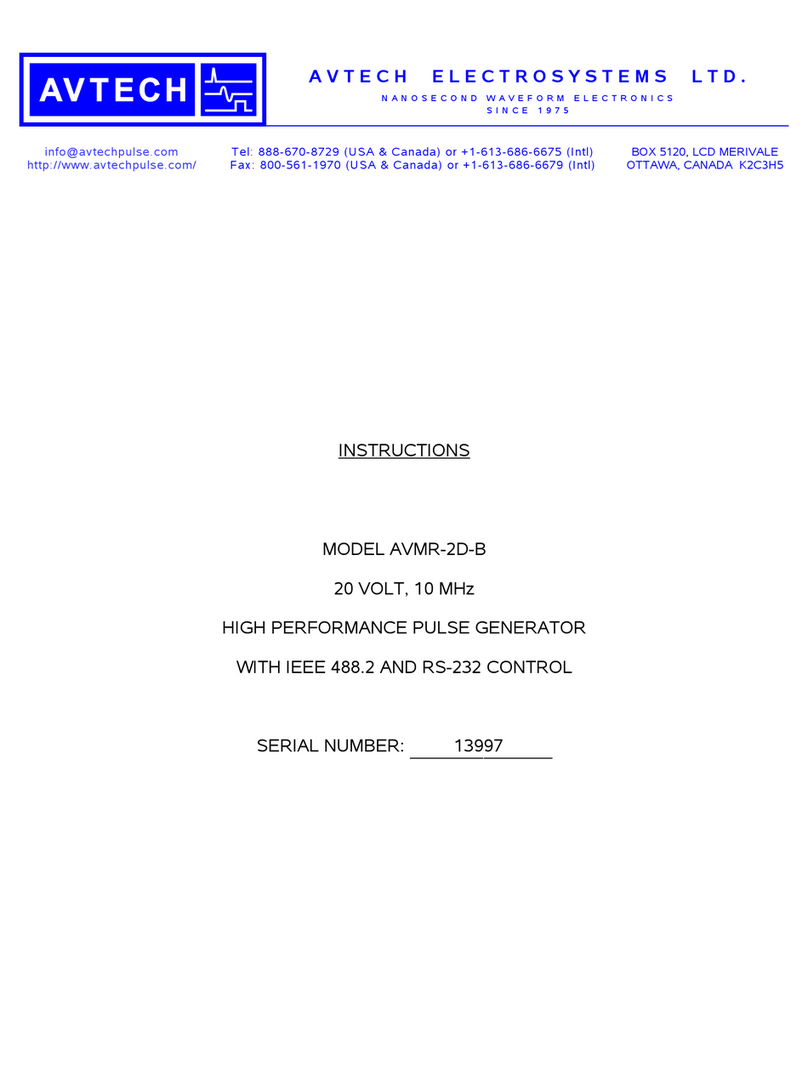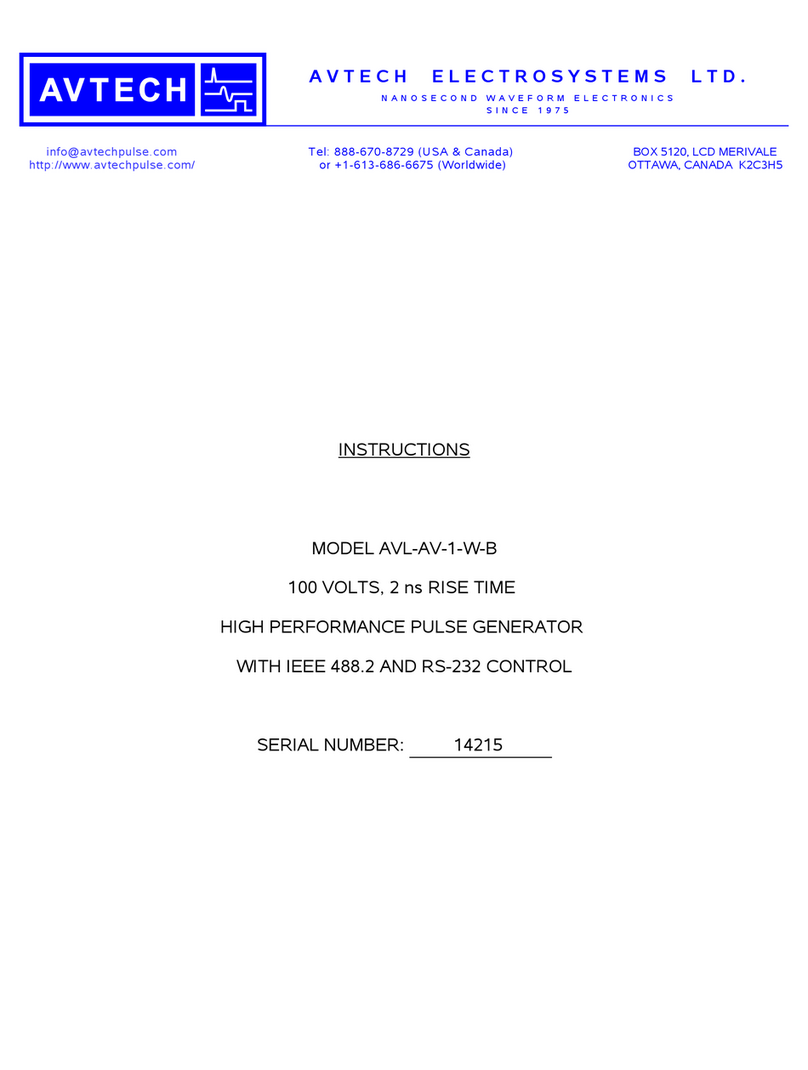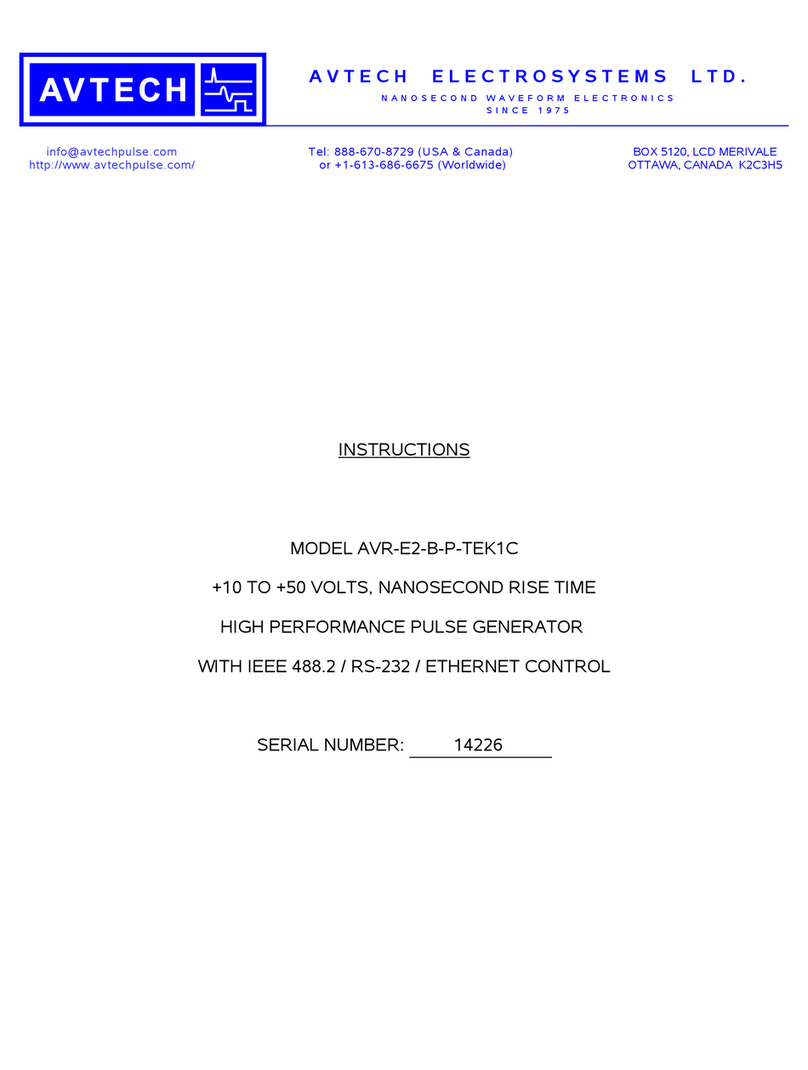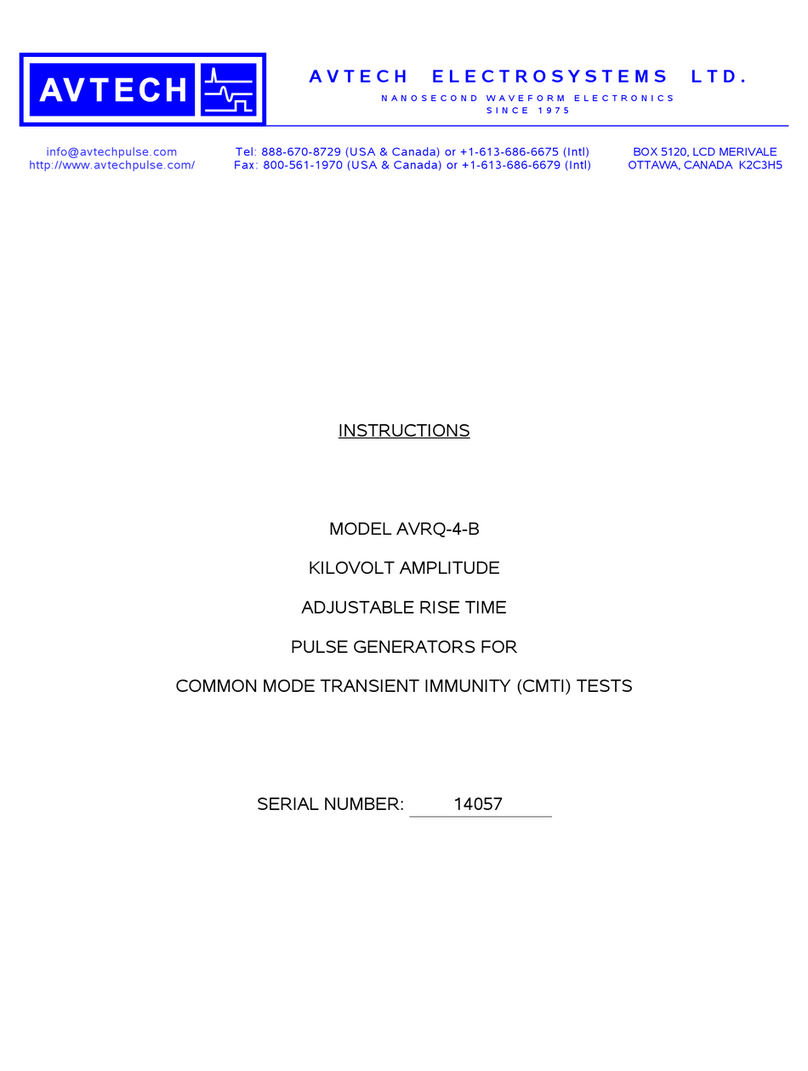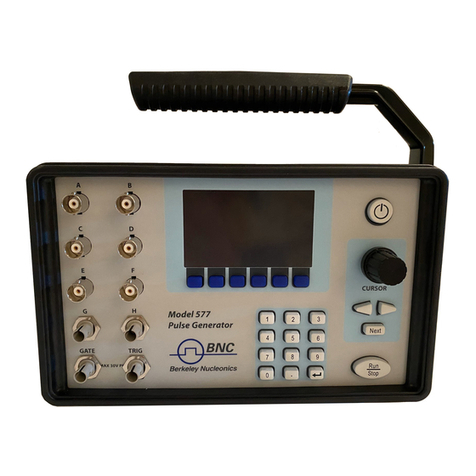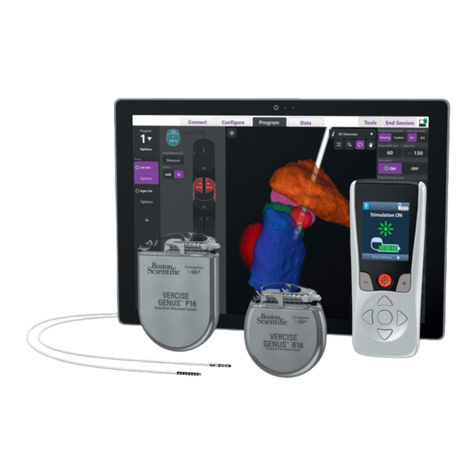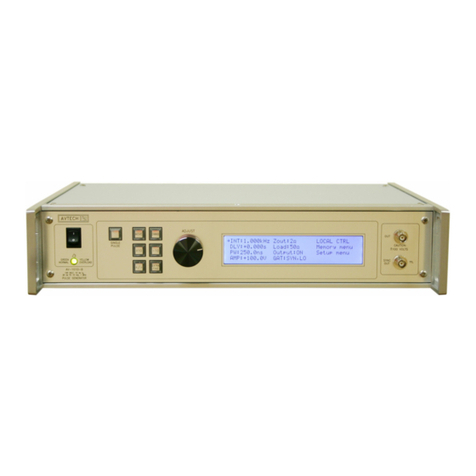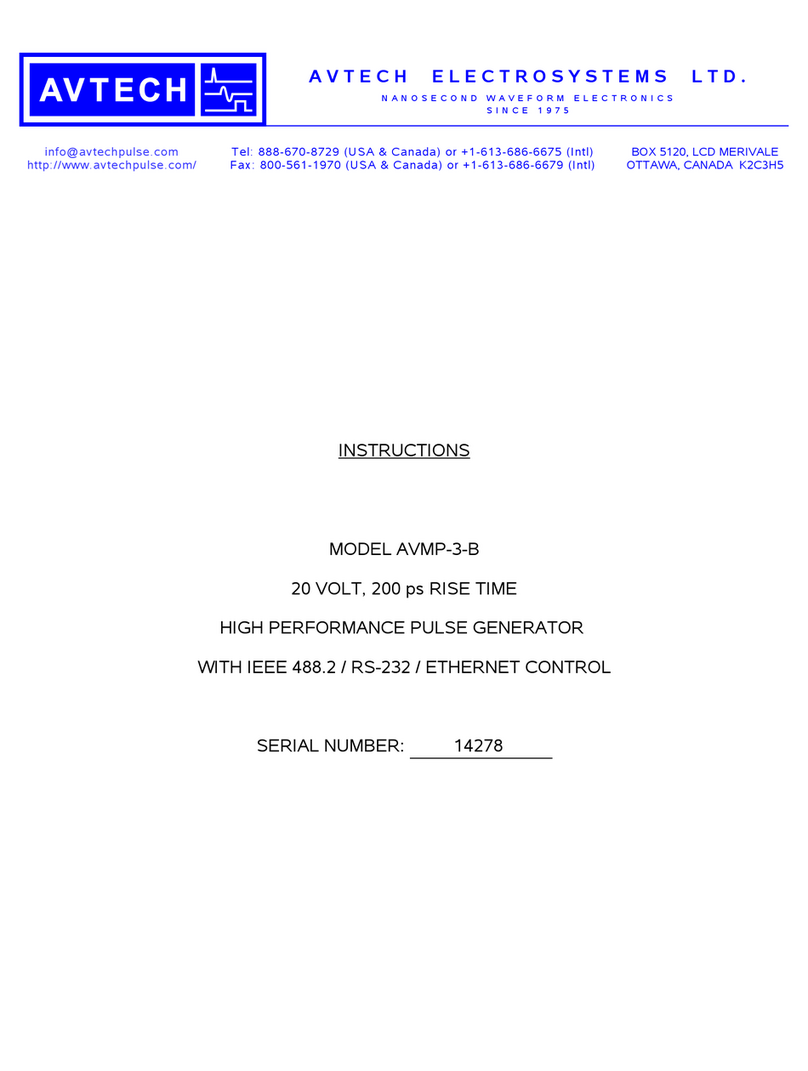Sepradel DG-3O1I-17 User manual

DG-3O1I-
17 Three Channel Delay Generator
User MAnual Rev. F
Soluciones y Tecnologías de Control
Embebido SAPI de CV
Bélgica 304A, Altamira, TAMPS, MX, 89606
+52 1 833 3894054

Soluciones y Tecnologías de Control Embebido S.A.P.I. de C.V.
www.sepradel.com contacto@sepradel.com +52 1 833-389-4054
i
Environmental Specifications
The Pulse Generator device with Programmable Delays, model DG-3O1I-17 is designed to work
indoors, according to the following ranges.
•Temperature Range: 10 ° C - 40 ° C
•Maximum Relative Humidity: 80% without condensation and temperature above 31 ° C.
•External Power Supply: 8VDC -12VDC, 2.5W.
•Power Supply from USB bus: 5VDC, 2.5W with electrical isolation1.
Feature of Secure USB by Electrical
The equipment, to which the DG-3O1I-17 device is commonly connected, can work with
potentials and high voltage signals (~ 10kV), for example laser equipment with active optical
switches. Such potentials can, due to installation error or loss of insulation, find a way to low
voltage (~ 5V) control lines damaging sensitive equipment. Therefore, the DG-3O1I-17 has a
SECURE USB for your computer equipment; for being designed according to industrial techniques
and components that provide electrical insulation according to standards.
•UL: 2500 V rms for 1 minute, conforming to UL 1577
•CSA # 5A Component Acceptance Notice
oIEC 60950-1: 600 V rms
•VDE Certificate of Conformity
oDIN V VDE V 0884-10 (VDE V 0884-10): 2006-12 VIORM = 560 V peak
Therefore, high voltage pulses that may be applied by mistake to the input or outputs of the
DG-3O1I-17, will not be transmitted to the computer equipment or to the external power supply.
The protection is in both directions, that is, some damage to the computer or transitory
equipment in the power line, nor will it be passed to the DG-3O1I-17 output lines..
1If the equipment is powered from the USB bus only, note that the output levels will drop to
approximately 4VDC. If the equipment to be synchronized accepts these levels, there is no problem,
otherwise, to obtain TTL output levels of 5VDC nominal, use alone or together with the USB the external
power supply provided with the equipment.


Soluciones y Tecnologías de Control Embebido S.A.P.I. de C.V.
www.sepradel.com contacto@sepradel.com +52 1 833-389-4054
iii
Tabla de contenido
Environmental Specifications ........................................................................................................ i
Feature of Secure USB by Electrical............................................................................................... i
Unpacking and Inspection ............................................................................................................ v
Unpacking your Delay Generator ............................................................................................. v
Components included............................................................................................................... v
Security advice..............................................................................................................................vi
Technical characteristics..............................................................................................................vii
Introduction.................................................................................................................................. 1
Input.......................................................................................................................................... 3
Outputs ..................................................................................................................................... 3
Internal Structure of the Delay Pulse Generator...................................................................... 3
Device behavior activating the pulse counter ...................................................................... 7
About the input parameter "Wait Time".............................................................................. 8
Using the Delay Generator as a Bounce Filter...................................................................... 8
Material and Mechanical Dimensions ...................................................................................... 9
Turning the DG-3O1I-17 On and Off......................................................................................... 9
Equipment Configuration and Control from Touch Screen ........................................................ 11
Configuring the Input Channel................................................................................................ 12
Configuring Output A.............................................................................................................. 16
Configurando Salida B............................................................................................................. 18
Configuring Output C .............................................................................................................. 19
Manual trigger with touch button "Soft Trigger" ................................................................... 20
Display contrast regulation..................................................................................................... 21
Active Q-Switch Generic Laser Connection Example.................................................................. 23

Soluciones y Tecnologías de Control Embebido S.A.P.I. de C.V.
www.sepradel.com contacto@sepradel.com +52 1 833-389-4054
iv
Trigger control via USB ........................................................................................................... 26
Example of Connection with commercial Quantel USA Laser with Source and Control Type
ICE450................................................................................................................................................ 27
Configure the Quantel USA laser............................................................................................ 27
Configure DG-3O1I-17 Delay Generator................................................................................. 28
DG-3O11-17 Input Configuration ....................................................................................... 28
Configuration of Output B for Q-Switchof the Quantel laser............................................. 29
Output C Configuration for Optical Spectrometer ............................................................. 29
Passive Q-Switch Laser Connection Example ............................................................................. 33
Problem resolution ..................................................................................................................... 35

Soluciones y Tecnologías de Control Embebido S.A.P.I. de C.V.
www.sepradel.com contacto@sepradel.com +52 1 833-389-4054
v
Unpacking and Inspection
Unpacking your Delay Generator
Your Delay Generator equipment was packed with great care and the container inspected
before shipping, so it leaves our facilities in good condition. Upon receiving your equipment,
immediately inspect the exterior of the container. If you find any major damage (box holes,
crushed areas, etc.), insist that a shipping company representative be present when unpacking the
contents. Carefully inspect and videotape the equipment as you unpack it. If any damage is
evident, such as scratches or dents on the chassis, broken glass display, broken or bent
connectors, etc., immediately notify the carrier and the seller. Secure the shipping box. If a claim is
drawn up, it may be necessary to show the damage and that it was as a result of the shipment.
Also, if you need to return the equipment for any update or repair, the original packaging may be
useful.
Components included
When you receive your container, verify that at least the following items are present:
1. The Delay Generator DG-3O1I-17
2. Wall eliminator with 9VDC output and 100VAC - 220AC input
3. A commercial invoice or final component list (useful in case of adding an optional
accessory to the shipment, such as a power spigot adapter for a region other than
America).

Soluciones y Tecnologías de Control Embebido S.A.P.I. de C.V.
www.sepradel.com contacto@sepradel.com +52 1 833-389-4054
vi
Security advice
ATTENTION: It is recommended for safety that before connecting the DG-3O1I-17 equipment
to a laser or other external device; the input and outputs of the DG-3O1I-17 are configured in
terms of the type of logic, see sections “Equipment Configuration and Control from Touch Screen”
page 11. Additionally, try:
•that the laser or other external equipment is turned off or its inputs are disabled
during adjustment of the DG-3O1I-17's input and output logic
•Before turning off the delay generator, first turn off the laser or external equipment,
see section “Turning the DG-3O1I-17 On and Off” on page 9
If a DG-3O1I-17 output is modified in terms of output logic, a level change will occur in it, for
example from 0V to 5V and the external laser that is connected to said output can detect the pulse
as a command to perform a laser shot, so if the proper precautions are not taken you would
inadvertently get a laser shot, with the risks that this implies.
So, know well the levels present in your system to control and if you will modify the output
logic or trigger edge of the "hot" input, consider the precautions for laser shots or possible
activations of the external system. Changes in delay or width of the output pulses do not affect
that the equipment outputs emit pulses.

Soluciones y Tecnologías de Control Embebido S.A.P.I. de C.V.
www.sepradel.com contacto@sepradel.com +52 1 833-389-4054
vii
Technical characteristics
•Model DG-3O1I-17
•Three independent TTL outputs
•The outputs are configurable as to type of logic (positive / negative), width of the
output pulse and delay with respect to the input event
•Outputs with protection against external short circuits and surges
•The input can be configured to respond to the rising or falling edge event of a
compatible TTL input pulse, but also supports 10V amplitude pulses
•Optional control and power from the USB bus
•Optional external power supply in DC-IN barrel connector: 9VDC - 12VDC
•Maximum consumption of 2.5W
•Delay Range 0.1 us - 6553.5 us
•Delay Resolution: 0.1 us
•Pulse Width Range: 0 us - 65535 us
•Pulse width resolution: 1 us

Soluciones y Tecnologías de Control Embebido S.A.P.I. de C.V.
www.sepradel.com contacto@sepradel.com +52 1 833-389-4054
1
Introduction
The DG-3O1I-17 delay generator is a device based on an FPGA programmable gate array
device. The latter allows to have an input and three really independent output channels. Control
of the device is carried out both from its touch screen and from a personal computer or laptop
(PC) through a USB serial bus and a computer application running on the PC. The use of a PC is
optional, useful for example to operate the DG-3O11-17 as part of an automated installation.
The DG-3O1I-17 can be understood as a device that with one input stimulus pulse generates
three output pulses. These output pulses are generated some time after the input stimulus and
with the following properties:
1. The delay between the input stimulus and the pulse of a given output is adjustable
and independent of any other output
2. The pulse width of an output is adjustable and independent of any other output
3. The digital logic2of a given output is adjustable and independent of the logic of any
other output
Fig. 1. Delay Generator front panel with input (IN) and outputs (OUT)
The figure above shows the panel with BNC connectors for “IN” input and “OUT” outputs. To
the left of each connector there is a light indication that can be yellow or red, depending on
whether the voltage is 0V or + 5V, respectively. In this way, when we connect a BNC cable to the
input, observing the color of the “IN” light indicator, we can determine the high or low level
presented.
2In our case, by output with positive [negative] logic we will understand an output whose signal level
always remains at “0V” [“5V”] and only goes to high [low] or “5V” [“0V”] during emission of a pulse.

Soluciones y Tecnologías de Control Embebido S.A.P.I. de C.V.
www.sepradel.com contacto@sepradel.com +52 1 833-389-4054
2
By changing the logic type of an output, the corresponding indicator will also change color. In
negative logic, for example, the output will remain high at all times and the indicator light will be
red, and will only change to low during the pulse width time that has been configured in said
output. For outputs, also consider that for small pulse widths, ~ 1 ms; the change of color of the
light indicator during the generation of the pulse, would go unnoticed to the naked eye.
The following figure shows the rear panel of the delay generator, which contains a USB
connector for data communication with a PC and / or power supply. To the far right of the rear
panel is the 9VDC-12VDC power connector. The device can be powered either from the USB bus
(connected to a PC or a cell charger), or from the DC-IN connector of 9VDC-12VDC, or both options
at the same time. Internally DC-IN will be chosen to decrease the consumption of the USB bus; but
if DC-IN fails or is removed while USB power is present, the device will automatically continue
uninterrupted power from the current source.
Fig. 2. Rear panel of the Delay Generator with USB port and 9VDC-12VDC Power input, touch
screen is also shown
The figure above also shows the area of the touch display. From the latter, parameters such as:
•The Logic of Entry
•The Output Logic
•The Delay at each Exit
•The pulse width of each output

Soluciones y Tecnologías de Control Embebido S.A.P.I. de C.V.
www.sepradel.com contacto@sepradel.com +52 1 833-389-4054
3
•The input Pulse counter3
Input
The input is based on a 50 Ωimpedance BNC connector; TTL type (with extended capacity for
pseudo-square pulses and up to 10VDC). The input has over-voltage protection, so momentary
input pulses outside the allowed range will be virtually short-circuited to prevent them from
entering the rest of the delay device modules.
An input stimulus can be the positive or negative edge of a square, triangular, or square-like
pulse, or a packet of input pulses, the amount of which is defined with the input counter option.
The input supports TTL pulses with voltages between 0V and 10V. This allows the direct
interconnection of a module for detecting short laser pulses, which although the output signal of
said photodiode module is analog, for being of short duration (in the order of tens of 10-9s), it is
closer to Virtually a square or triangular pulse with a very steep rising and falling edge, so it will be
detected by the delay generator without major complexity.
Outputs
Like the input, the outputs are also BNC and TTL type, with a nominal impedance of 50 Ω,
protection against short circuits and external overvoltages. They have a current capacity of 80 mA
and a maximum output voltage of 5VDC.
Internal Structure of the Delay Pulse Generator
The following figure shows in a simplified way the structure or internal logic of the Pulse
Generator with Programmable Delays DG-3O1I-17.
3The function of Counting pulses at the input will be detailed later, but basically allows the Device to
activate the outputs only when a certain number of pulses have arrived at the input. This is useful, for
example, in multipulse lasers, to trigger the spectrometer only with the arrival of the nth laser pulse and not
only in the first one. Another use is to activate a spectrometer and a Q-switch every certain number of flash
lamp shots, so our laser would maintain a high frequency of flash flicker while the Q-switch and the
spectrometer only activate at a submultiple of the flash lamp frequency.

Soluciones y Tecnologías de Control Embebido S.A.P.I. de C.V.
www.sepradel.com contacto@sepradel.com +52 1 833-389-4054
4
Fig. 3. Structure or internal logic of the delay generator
In the previous figure, we have the following blocks:
•IN: It is the Pulse input to the equipment
•Out A, Out B and Out C: These are the pulse outputs of the equipment
•Pulse Counter: Counter block of the pulses that enter through IN, emits a pulse
towards the “Selector” block every time the count programmed by the user is reached
from the equipment's touch screen.
•Selector: Block that selects between the “IN” input or the “Pulse Counter” output to
connect to the delays of the “Out B” and “Out C” outputs
•Delay A: Block that performs the delay function for the “Out A” output, receives a
pulse directly from “IN” and a configurable “dA” time, then emits a pulse in “Out A”
with a duration or value width "Wa"
•Delay B: Block that performs the delay function for the “Out B” output, receives a
pulse from “IN” or from “Pulse Counter” depending on the position of the “Selector”
and a configurable time “dB” then emits a pulse in "Out B" with a duration or width of
value "Wb"
•Delay C: Block that performs the delay function for the “Out C” output, receives a
pulse from “IN” or from “Pulse Counter” depending on the position of the “Selector”
and a configurable “dC” time then emits a pulse in "Out C" with a duration or width of
value "Wc"
Note that the "Out A" output differs from "Out B" and "Out C" in that the latter can receive a
pulse from the "Pulse Counter" module or directly from "IN", depending on the position of the
"Selector" module, but "Out A" only receives pulses directly from "IN" through its "Delay A". Such
configuration of outputs allows in those applications where it is necessary to control the firing of a
flash lamp from the DG-3O1I-17 uninterruptedly, while an optical switch (Q-switch active) is

Soluciones y Tecnologías de Control Embebido S.A.P.I. de C.V.
www.sepradel.com contacto@sepradel.com +52 1 833-389-4054
5
activated only every certain number or count of shots in the flash lamp. Then, the control of the
flash lamp would be taken directly from "Out A" while the active Q-switch would be controlled
from "Out B" and a third external component, for example an optical spectrometer, would be
controlled from the output "Out C " For the input configuration menu and to activate the counter,
you can consult page 12 of this manual.
The following figure shows the behavior of the outputs when the retarder is configured with
delays "dA", "dB", "dC" and pulse widths "Wa", "Wb" and "Wc" respectively on the output
channels "Out A ”,“ Out B ”and“ Out C ”, while the“ IN ”input is configured to use the rising edge of
an input pulse as“ zero ”time or reference to start the delays of each output. During the emission
of a pulse in some output channel, said channel will not attend to another event in the input
channel, and this does not affect neighboring channels.
Fig. 4. Behavior of the outputs with respect to an input pulse, pulse counter deactivated

Soluciones y Tecnologías de Control Embebido S.A.P.I. de C.V.
www.sepradel.com contacto@sepradel.com +52 1 833-389-4054
6
Fig. 5. Behavior of the outputs with respect to an input pulse, pulse counter deactivated and with output channels
C and A in negative logic

Soluciones y Tecnologías de Control Embebido S.A.P.I. de C.V.
www.sepradel.com contacto@sepradel.com +52 1 833-389-4054
7
Fig. 6. Behavior of the outputs with respect to a negative logic input pulse, with falling edge detection activated at
IN input
Device behavior activating the pulse counter
Fig. 7. Structure of the Delay Generator when the Pulse Counter is activated, in the example it was configured to
detect 4 rising edges
The following graph shows the behavior of the outputs with respect to successive “IN” input
pulses. Note that the output channel "Out A" emits a delay pulse "dA" and width "Wa" for each
rising edge detected in "IN", while the outputs "Out B" and "Out C" emit their pulses with delays
and widths "dB", "Wb" and "dC", "Wc", respectively when the pulse count configured in the "Pulse
Counter" module is reached, in the case of the example it was configured to count four edges of
rise at the "IN" entrance.

Soluciones y Tecnologías de Control Embebido S.A.P.I. de C.V.
www.sepradel.com contacto@sepradel.com +52 1 833-389-4054
8
Fig. 8. Behavior of the outputs with the Pulse Counter activated to detect 4 rising edges, regardless of the time
variation between input edges
About the input parameter "Wait Time"
It should also be mentioned that in the input configuration “IN” (see page 12), there is a
parameter called “wait time” in units of microseconds. This parameter is only used when the pulse
counter is activated and defines the time pause to be made after making a total count and before
starting the next count. During the wait time the equipment will not consider new pulses.
Using the Delay Generator as a Bounce Filter
It was previously mentioned that during the emission of a pulse in one channel, the latter will
not attend to another input event and that this does not affect neighboring channels. This feature
can be used by the user to obtain clean “bounce” delay outputs. For example, if you know that
two consecutive short pulses are eventually received at the input, but you only want to consider
the first one, then you can configure an output with the minimum possible delay and a pulse width
in said output greater than the total period of the received pulses. In this way, the Delay
Generator will not attend to the second short input pulse and would obtain only one output pulse
without the inconvenience of bouncing.

Soluciones y Tecnologías de Control Embebido S.A.P.I. de C.V.
www.sepradel.com contacto@sepradel.com +52 1 833-389-4054
9
Material and Mechanical Dimensions
•158.28 mm X 130 mm X 37.4 mm . The housing is made of anodized aluminum.
Fig. 9. Delay Generator Dimensions
Turning the DG-3O1I-17 On and Off
The equipment is powered on as soon as the 9VDC-12VDC DC-IN power supply is connected to
the DG-3O1I-17, or to the USB bus of a PC or Cell phone charger. The equipment has a low power
consumption of 2.5W maximum. At the end of a day, it is recommended to first turn off or
disconnect the laser connected to the DG-3O1I-17 and then disconnect the external power supply
from the delay generator. In the case of power from the USB bus of a PC, keep in mind that when
turning off the PC the USB bus can remove the power from the retarder, and the output lines will
remain or go to low level or 0V which could activate processes of shot on the laser or external
device.
In summary, it is recommended that the shutdown of the DG-3O1I-17 be performed after
securing or disconnecting the laser or equipment connected to the retarder and then switching off
the external source, PC or USB charger of the DG-3O1I-17.


Soluciones y Tecnologías de Control Embebido S.A.P.I. de C.V.
www.sepradel.com contacto@sepradel.com +52 1 833-389-4054
11
Equipment Configuration and Control from Touch Screen
When energizing the DG-3O1I-17 equipment, its inputs and outputs will be automatically
configured with the last configuration used. When turning on the equipment, the home screen
similar to the one shown in the following figure will appear on the touchscreen.
Fig. 10. Delay generator home or main screen
From the home screen you have access to the configuration of the three output channels or
"DIGITAL OUTPUTS", called "A", "B" and "C" and which correspond to the BNC connectors marked
with the same name on the panel front of the equipment, see Fig. 1 on page 1. Likewise, the touch
button called “INPUT” allows access to the input channel parameter configuration window.
The area marked "ZONE TO CUSTOMIZE YOUR LOGO, IMAGE, ETC." is a graphic area for the
user to locate the logo of your company or institution or other relevant information. For example,
the following image shows this personalized area according to the requirements of the laser
laboratory of the La Plata Optical Center4.
Fig. 11. Home screen with custom zone
4https://ciop.conicet.gov.ar/

Soluciones y Tecnologías de Control Embebido S.A.P.I. de C.V.
www.sepradel.com contacto@sepradel.com +52 1 833-389-4054
12
For the personalization of the home screen, the user can send a file in JPG format with their
design, the dimensions must be 270 x 50 pixels. You can also leave the customizable area blank.
In addition to the "DIGITAL OUTPUTS" and "INPUT" buttons, the home screen shows a "SOFT
TRIGGER" and "ABOUT" button, these will be described in subsequent sections.
Configuring the Input Channel
By pressing the touch button denoted by “IN” on the main screen (see Fig. 10), you will access
the input channel configuration screen, similar to the following figure.
Fig. 12. Pantalla de configuración del canal de Entrada
When accessing a window, the quantities displayed by each control are those currently
configured on the equipment. To modify them, press on the control or indicator in question, which
will open a numeric keyboard. The input parameter named "wait time" was mentioned on page 8.
Tabla 1. Input Channel Controls Description
Control
Range of Values
Function
“Trigger with
falling edge?
Mark/No Mark
Without checking, the output pulses will start their
delays with respect to the positive edge of the input
pulse, that is, when the input changes from "0V" to a
voltage between "2.5V -
10V". If checked, then the
equipment will only respond to negative edges of an
input signal, that is, when the input is changed from a
high potential of "2.5V - 10V" to a lower potential of
"2V".
Table of contents
Popular Pulse Generator manuals by other brands

Abbott
Abbott Proclaim 3660 Clinician manual

Tektronix
Tektronix TYPE 109 instruction manual
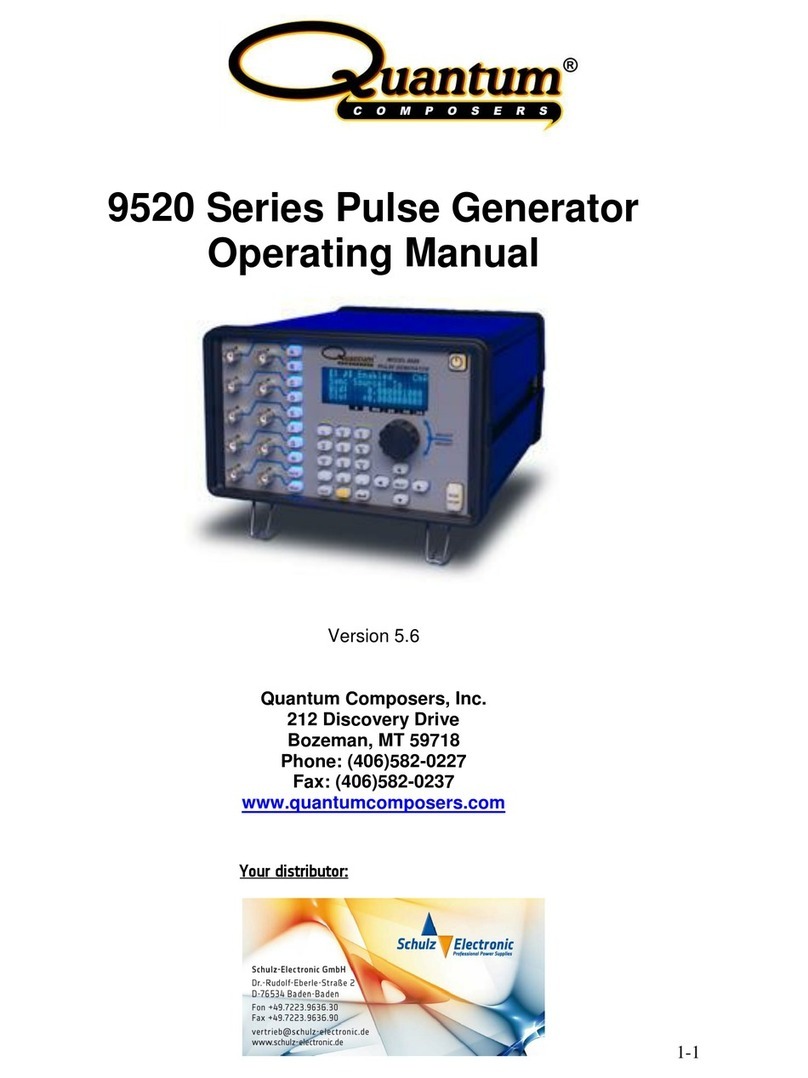
Quantum Composers
Quantum Composers 9520 Series operating manual
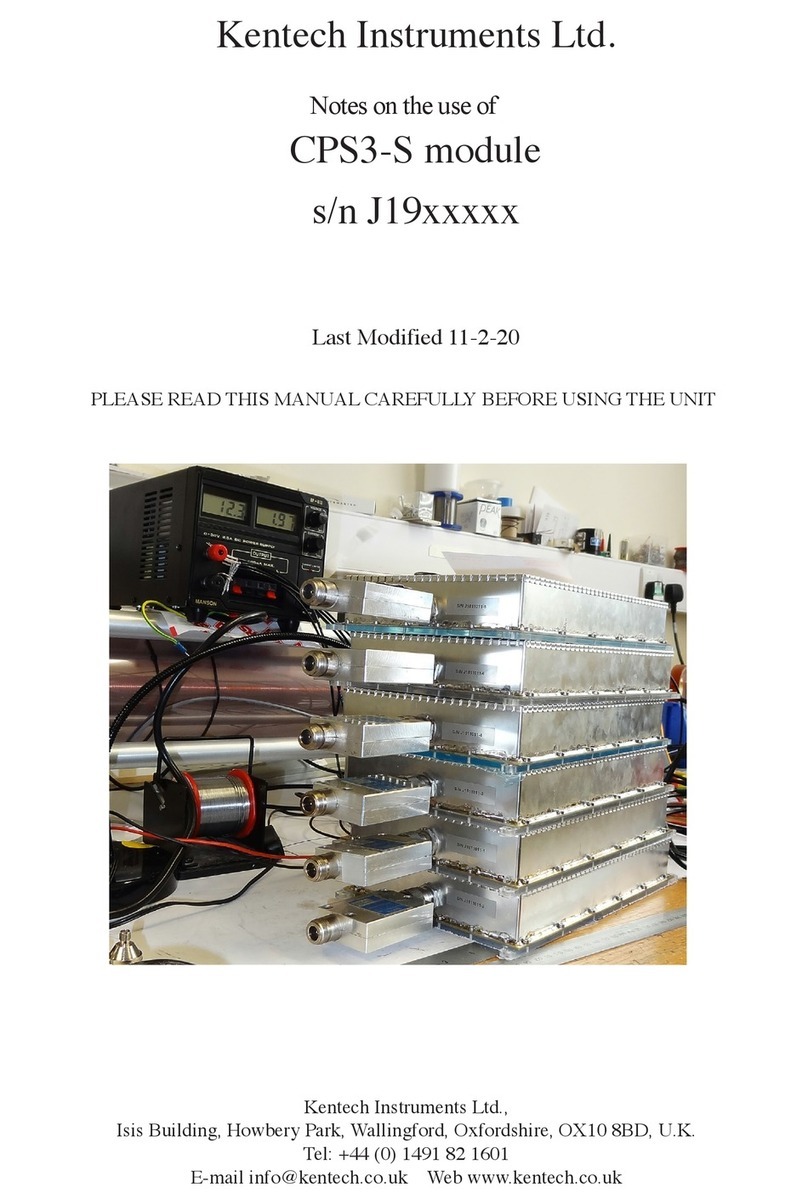
Kentech Instruments
Kentech Instruments CPS3-S Notes on the Use

HP
HP 8112A Operating, programming and servicing manual

Quantum Composers
Quantum Composers 9530 Series operating manual
